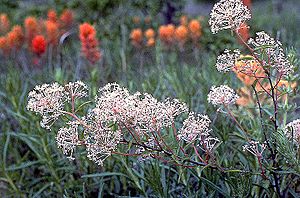Jersey tea facts for kids
Quick facts for kids Jersey tea |
|
|---|---|
 |
|
| Scientific classification | |
| Genus: |
Ceanothus
|
| Species: |
herbaceus
|
| Synonyms | |
Ceanothus herbaceus, often called Jersey tea, is a type of shrub found in North America. It belongs to the Rhamnaceae family, which includes many different kinds of plants. This plant is a perennial, meaning it lives for more than two years and comes back each growing season. It shares some similarities with other shrubs like Ceanothus americanus and Ceanothus sanguineus.
Contents
What is Jersey Tea?
Besides its scientific name, Ceanothus herbaceus has several common names. People also call it narrow-leaved New Jersey tea, inland ceanothus, inland Jersey tea, prairie root, and smaller redroot. These names often describe where it grows or what it looks like.
Where Does It Grow?
Jersey tea grows naturally across a large part of North America. In Canada, you can find it from southeastern Manitoba all the way to Quebec. In the United States, it grows from Montana in the west to Massachusetts and Virginia in the east. Its range extends south from the Rocky Mountains to New Mexico, and east to Arkansas and Louisiana.
Its Home and Friends
This plant is quite tough and can handle dry conditions. Its roots can grow very deep, sometimes up to 15 feet! Jersey tea likes to grow in soil that drains well and needs lots of sunshine. After a fire, its new shoots from the base tend to grow back quickly.
The Jersey tea plant is also important for some insects. For example, it's a host plant for the mottled duskywing butterfly (Erynnis martialis) in eastern North America. This means the butterfly's caterpillars eat the leaves of the Jersey tea plant.
What Does It Look Like?
Ceanothus herbaceus is an upright shrub that usually grows between 0.5 and 1 meter tall (about 1.5 to 3 feet). It often has a rounded shape, with branches that spread out or grow upwards. The younger branches are flexible and green. The main stem has grayish-brown bark.
Leaves and Flowers
The leaves of the Jersey tea shrub grow in an alternate pattern along the stem and fall off in the autumn. Each leaf has a small stalk, about 3–5 mm long, that attaches it to the stem. The leaves themselves are usually between 35–74 mm long and 10–32 mm wide. They can be wide or narrow, shaped like an ellipse or a lance, and come to a point at the end.
Each leaf has three main veins that start just above its base. The edges of the leaves are serrated, meaning they have small, rounded teeth. The top surface of the leaf is a dull green and mostly smooth. The underside is also dull green but has soft hairs, and it often dries to a rusty brown color.
The plant produces clusters of small, white flowers at the ends of its branches. These clusters are about 15–30 mm long and have a rounded shape. Each flower cluster is held up by a long stem called a peduncle, which is typically 26–48 mm long.

Flowers and Fruit
The small, white flowers of Jersey tea grow in dense, rounded clusters, usually about 0.5 to 0.75 inches wide. Each flower has five petals and five sepals, which are like small leaves that protect the bud. The flowers are spoon-shaped and have five stamens, which are the parts that produce pollen.
After the flowers are pollinated, the plant grows a fruit. This fruit is a three-lobed capsule, about 3–4.5 mm wide. When the fruit is ripe, it opens up to release its seeds. The seeds are usually brown, 2–2.5 mm long, and can be round or egg-shaped.
Jersey tea flowers bloom between March and August, and its fruits appear from July to September. The flowers attract insects, which help with pollination. The fruits and seeds are a food source for birds, including the bobwhite quail. This plant also serves as a host for the azure blue butterfly.
How People Use It
Historically, different Native American tribes have used Jersey tea. The Ojibwe people made a special liquid from the root to help with coughs. The Brulé Lakota brewed the leaves to make a tea.
Today, people sometimes grow Jersey tea as an ornamental plant in gardens because it's pretty. It also has a special relationship with certain bacteria in the soil. These bacteria help the plant by changing nitrogen from the air into a form the plant can use. This is called a symbiotic relationship. The roots of Jersey tea are still used in some traditional remedies for things like asthma, bronchitis, and coughs. The flowers are rich in a substance called saponins, which can be used to make soap!
Protecting Jersey Tea
Unfortunately, Ceanothus herbaceus is an endangered species in several states. This means it's at risk of disappearing from the wild in places like Illinois, Indiana, Kentucky, New York, Ohio, and Vermont. Efforts are being made to protect this important plant.

